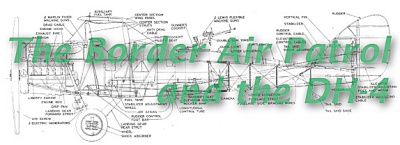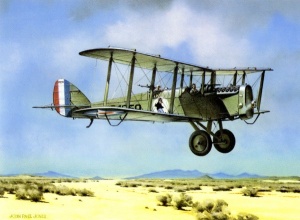This site is best
viewed at 800x600
and 16 bit color.

In 1919, Mexican bandits were causing great concern amongst cattle ranchers in the U.S. Raiders like Pancho Villa and Jesus Renteria were notorious in their raids across the border, stealing cattle and killing ranchers. After Villa’s attack on Juarez that left many Americans dead, the U.S. Government sent a number of airplanes to establish an aerial patrol along the border. Several squadrons, including the 20th and 11th Aero Squadrons, received orders to move to Fort Bliss Texas. Twelve DH-4 bombers of the 20th Aero Squadron left on June 20 from Ellington Field with the supporting troops following by train. The difficulties of flying simple planes in primitive areas was quickly made apparent, with two plane crashes at Del Rio, one of which was fatal. The landing fields were very primitive, and in some case nonexistent. These difficulties were amplified by the DH-4, which was not a very rugged airframe. As the planes got further and further away from civilization, another problem appeared. The Liberty engine powering the US version of the DH-4 required the highest grade of gasoline and oil, both of which were in short supply at the forward fields. Gasoline had to be strained through chamois, making the fueling process slow and tedious. The oil, while good, was not good enough for the Liberty engine, resulting in much shorter flight times than normal.
Trying to keep everyone in order was Major E.G. Tobin of the 11th Aero Squadron, the first CO of the Border Air Patrol. He flew the first mission on June 19th. During the next few days, the 12th, 96th, and 104th Aero Squadrons, all of whom recently returned from overseas duties in Europe, joined the 11th and 20th at Fort Bliss. On July 7th, these five squadrons became the First Bombardment Group, and were made responsible for patrolling the air from Nogales, Arizona to Boquillas, Texas.

"Border Patrol"
by John Paul Jones, pastels, 1978.
Pictured is a DH-4 of the 11th Aero Squadron flying a patrol
between El Paso and Marfa, Texas in 1919.
With the establishment of the 1st Bombardment Group, additional aerodromes were set up at Douglas, Arizona and Marfa, Texas, with the group headquarters located at the Fort Bliss aerodrome. Patrols were continued through July, and in mid-July the 8th Aero Squadron was transferred from Kelly Field to McAllen and Sanderson, Texas. At the same time, the 9th Aero Squadron was assigned to Rockwell Field, North Island, San Diego. The 9th flew the border from San Diego to Yuma and Quitobaquita, Arizona, where they met up with the flights coming out of Douglas. In this manner, the entire border between Mexico and the U.S. was covered by 8 squadrons, piloted by officers that were combat-tested in the skies over Europe. On August 15th, Major L. A. Walton succeeded Major Tobin as CO of the group. As the group’s main purpose was observation rather than bombing, the designation was changed to the 1st Surveillance Group in November. Due to the length of the border, actual patrolling strength varied. Roughly 7 squadron with 85 planes and 175 flying officers patrolled the 2000-mile border.
The defeat of Villa at Juarez and his escape into Mexico was the moving force in creating the Border Air Patrol. Pinpointing Villa’s location was a priority. It was thought that he ran into the mountains across the Rio Grande from the Big Bend and Upper Bend districts. This area was populated with Villa sympathizers, especially after Villa captured Ojinaga and other villages from the Mexican federal troops. Another rumor was that Villa and his band went south to his hideout in the Santa Clara Canyon, where natives helped keep them safe from the Mexican troops. With these two locations being possible Villa sites, the Border Air Patrol focused operations along that border stretch, flying their DH-4s low and looking for bands of men. When a possible band was spotted, a count was made of the number of men, horses, and cattle. This tally, plus a sketch of the location, was then dropped at the closest calvary outpost. The 8th Calvary had nearly a dozen outposts in the Big Bend/Upper Bend area that were accessible by wagon, and many more that required pack animals to get to. These troops would act on this information and investigate anything suspicious or out of the ordinary. The timing of these flights varied from day to day, so no set pattern emerged. This effectively stopped the raiding of American ranches, as the raiders with their cattle and horses were very visible from the air. Smaller bands of men were harder to track down, as they could hide in the canyons and bushes until nightfall, but small bands generally didn’t do much harm.
The DH-4 that the Border Air Patrol used was the Liberty engined version, and it met with mixed reviews from the pilots. Some liked it, while others did not, but knowing that there was nothing else, accepted it. The plane had a ninety gallon fuel tank between the pilot and the observer, making communication very difficult. There was also a 5-gallon emergency tank on top of the wing, but this was often empty because of the airflow over the overflow tube. The exhaust tubes ran the length of the fuselage and ended up about three feet in front of the pilot. This didn’t matter much during the day, but the afternoon missions often went into the dusk hours, and the exhaust flame blinded the pilot at night. The Liberty engine itself was a water-cooled V-12, which was not the best choice for a dry, hot environment. The water needed to cool the engine added a lot of weight to the plane, reducing overall performance. The tremendous beating the engine took under these conditions resulted in a peculiar situation where the oil would burn up before the gas. This generally occurred after about three hours of flying time. A top speed of around 100 to 115 miles per hour could be reached, depending on the altitude flown and how well the plane was rigged.
Rigging of the DH-4 was as much an art form as it was a science. The rigging had to be redone quite often, and it was difficult to get the rigging trimmed perfectly in those primitive environs. The ailerons were not balanced, so the plane was heavy on the controls, and there was never enough offset to the rudder to counteract the propeller torque, resulting in lots of right rudder being needed. These combined to making the plane a difficult one to fly, and sitting in one for four hours flying over the desert of the southwest taxed even the best of pilots.
Communication, both between the pilot and observer and between the plane and the ground was of great importance. With the fuel tank between the pilot and observer, the only way for them to communicate was by having the pilot throttle the engine way back and then shouting back and forth. Between the plane and ground was more of a challenge. Each DH-4 had a radio sending set and telegraph key, so Morse code messages could be sent to the ground. The antenna was a flexible copper braid that extended in flight by gravity and was hand-cranked in by the observer. Power for this set came from a wind-driven generator on one of the landing gear struts. The range of this system was 25 miles, but the primitive electronics and widely changing landscape generally rendered the system useless.
Navigating over this barren land was done with road maps, which showed towns, rivers, and railroads on the US side, and nothing on the Mexico side. A compass could be used to plot a course, but with the variable winds at altitude, that quickly became ineffective. Also, the engine vibrations would rotate the compass needle, making the pilot think he was off course. So, most of the navigation was done with visual markers. With all these difficulties, it is very surprising that there were so few losses.
The month of August 1919 was an eventful month for the Border Air Patrol. It started out with the disappearance of Lieutenants Peterson and Davis from their August 10th patrol. A large air search was conducted along both sides of the border and deep into Mexico until August 17th. On the 17th, a bandit called Jesus Renteria sent a note to a storekeeper in Candelaria, Texas, stating that he had captured the two men and was holding them for a $15,000 ransom. After two days of negotiating, the commander of Troop K, 8th Calvary crossed the Rio Grande at midnight and rescued the two men after paying only half of the ransom. At daybreak, three hundred troopers from the 8th Calvary crossed the Rio Grande in pursuit of Jesus Renteria. Flying ahead of these troops, Lieutenants Frank Estill and Russell H. Cooper located Renteria and two of his men in a canyon. Cooper opened fire with his Lewis machine gun and killed Renteria and his white horse. The Calvary captured many members of Renteria’s band, and they were court-martialed and executed in Texas. The rapid withdrawal of US forces after this mission helped improve relations between the Mexican and US governments, with the result of a 50,000-peso reward being put out by the Mexican government on Pancho Villa.
Don't miss Part II of Border Air Patrol Next Month!